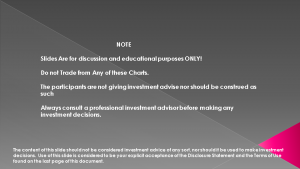IN-DEPTH: TRANSCRIPTION - LONGWave - 12-13-23 - DECEMBER – TECHNICAL SIGNALS: Yield Curve, US$ & Gold
SLIDE DECK
TRANSCRIPTION
SLIDE 2
Thank you for joining me. I'm Gord Long.
A REMINDER BEFORE WE BEGIN: DO NO NOT TRADE FROM ANY OF THESE SLIDES - they are COMMENTARY for educational and discussions purposes ONLY.
Always consult a professional financial advisor before making any investment decisions.
SLIDE 3 - COVER
As we wrap up 2023 and look towards 2024 we begin the annual process at MATASII.com of writing our annual Thesis Paper and outlining our 2024 UnderTheLens Macro Themes and 2024 LONGWave Investment Themes. In preparation for establishing the Themes we always do a deep dive into what the markets are technically signaling. This year will be no different as we begin with the “Big Picture”
technical perspective and “drill down” from there.
CHARTS 4
As such we will distill that larger research effort down to the items outlined here. These are technical market signals that are underway and as such we can expect to influence the 2024 economic and financial landscape.
CHART 5
We will start with some charts our long term subscribers will no doubt quickly recognize but importantly need to be included as part of our 2024 framework.
CHART 6
We have found this long-term chart of the DJI: Gold Ratio to be particularly insightful and has helped us over the years to get the major market trends right.
It highlights the cyclical periods of stagnation we experienced in the 1970’s and the post Dotcom to GFC eras. It is signaling we are at a major cusp of another period of Stagnation or the possibility of a continuation of the current rising trend if programs like Quantitative Easing are again adopted.
CHART 7
Our research has decidedly placed us in the camp of a downward movement with worsening Stagnation, Unfolding Stagflation and a potential Debt Crisis as the Beta Drought Decade unfolds.
CHART 8
We can always be wrong of course because the form Monetary and Fiscal Policy will take can and often does diverge from expectations based on major unfolding Geo-Political events.
However, the level and rate of growth of global debt to GDP, the degree of financial derivative leverage and increasing geo-political risk continues to support our expectations. The current movement towards Re-Shoring and De-Risking is only further moving the world further along in the advancement of De-Globalization, De-Financialization and slowing Mercantilism which we have been outlining for some time now.
Clearly the era of the Great Moderation has come to an end and lending rates can be expected to establish new levels, higher than the historic levels experienced during the Great Moderation. The global ability to fund existing debt levels has begun crowding out productive investment and savings within governments, corporations and consumers. We can expect slowing and even shrinking rates of growth in standards of living over the next decade.
CHART 9
In our new world of Creditism versus Capitalism we have reached the point where we no longer can grow Credit fast enough relative to economic growth.
This doesn’t mean the world is coming to an end, only that we require a period of consolidation, debt stabilization and adjustments in expectations, institutional governance and social norms.
Change is coming as part of the well documented Fourth Turning before the world continues on its ever evolving path.
CHART 10
The yield curve is one way to bring the elements of the big picture into a clearer focus within the context of developments that may unfold in 2024.
CHART 11
The top panel shows the historical Yield Curve for the 10Y US Treasury less the Fed Funds Rate. On the left is the pattern that unfolded prior to and during the 200 Dotcom Bubble and the 2008 Financial Crisis. The middle frame shows the corresponding movement in the S&P 500 and the bottom panel MATASII’s momentum indicator for the Yield Curve change.
The labels in the yield curve frame point out that during both crisis the yield curve inverted twice (in yellow) before going positive (pink) at which time the S&P 500 experienced its major declines and lost momentum. The economy experiences well telegraphed difficulties over a 24 – 30 month period before finally showing heavily in the equity markets.
On the right we can see that Covid stimulus has distorted the pattern and effectively dragged out the process but nevertheless we have had two inversions and it can be expected that as we get closer to the Fed pivoting the yield curve will positively steepen and then move into it traditional slope of longer term yields being higher than the Fed Fund rate. That is when the market historically sells off as the realities of why the Fed is reducing rates hits – a recession starts taking its toll.
You can see a dotted line laid in that says that will likely happen in 2024. It will be sooner than the dotted line suggests – but how much sooner?
CHART 12
Again we drill down. A simple reality is that the Federal Reserve does not lead but follows the markets. Specifically, the Fed Funds Rates follows the 2 Year Treasury Note Yield. When the two year note falls it isn’t long before the Fed follows and starts cutting rates.
The two year note has started falling and is signaling that the Fed will soon follow.
CHART 13
As this chart with the Yield Curve as measured by the 2Y Yield minus the Fed Funds rate illustrates, when that difference gets into the current area we are in an area of instability in the markets. The overall market forces actions in both yields. One controlled by the Fed, the other controlled by the funding markets. When the Federal Reserve is forced to increase rates at accelerated rates (as shown by the dotted lines) it is almost assured that the historical reaction will be the eventual potential destabilization of financial markets.
CHART 14
The market is currently estimating that pivot to begin in March.
Sahm’s Rule postulates that a recession is triggered when the average U-rate is 0.5% higher than the minimum 3-month average of past 12 months. From the November payrolls report this suggest this would be triggered by U-rate above 4% and occur in the next 2-3 months.
Since the markets until November have “sold the last hike”, which occurred in July, we have likely been in the window of seeing front-running of the 1st negative payroll. The November 3.7% Unemployment rate suggests they may be a little early in the "front running" trade. We can expect to see yet another reversal (to the downside) once the data unambiguously shifts from “soft” to “hard”.
CHART 15
This scenario tracks pretty well with the historical aggregation of the Yield Curve, Unemployment Rate and S&P 500 levels associated with market dislocations.
CHART 16
We have a lot of other confirming data but a nice confirmation is about Consumer spending and consumption since the US is a ~70% Consumption Economy. It is all about the US Labor market. The US Labor market remains decisively soft. Hiring of labor is slowing with the JOLTS report down but as yet no firing of labor (no negative payrolls). However, growth of Temporary Workers is now contracting by -6% Y-o-Y which historically has always coincided with the US ALREADY being in a Recession?
CHART 17
We are getting very close and the red dot may soon arrive quite quickly.
CHART 18
The 5Y Bridge between the 10Y and 2Y is further confirming the analysis.
Of course anything unexpected can always happen and you can never underestimate what the powers will do – they often change the rules to get the outcome they desire. The wild card here is potential re-emerging inflationary pressures which could add delay to the analysis.
CHART 19
Let’s now look at the technical signals coming from the US Dollar for confirmation or divergence.
CHART 20
The US Dollar is presently in the last leg of a major Elliott Wave degree correction. This leg is a Red “C” wave coming off the “B” wave bottom shown here. It has completed its initial “1” Wave and beginning downward “2” Wave.
CHART 21
That 1-2 Wave is shown here with a completed 1-2 within it also now completed. The red arrow shows the current expectations which are retracing much of the previous inverse Head & Shoulders pattern.
CHART 22
We further expand the pattern for more granularities and see a number of alternative targets and time frames.
Expectations are that we will see overall weakness in the US dollar throughout the US Presidential election cycle.
A weakening dollar is normally positive for stocks but poor for bonds with rising yields required.
CHART 23
But that isn’t always the case for various reasons. So let’s first look at US Treasury Bonds as represented by the accepted Risk free benchmark as the 10Y US note.
CHART 24
Clearly, 2024 has every technical indication of weakening yields which matches expectations with US Federal Reserve actions.
CHART 25
The fall in yields in 2024 may not be as large as markets expect with 3.0-3.5% being on the low end of the trading range. The Fed may aggressively take down the short end but the long end it going to be a problem without the re-introduction of Quantitative Easing.
CHART 26
The quite Bearish “Island Pattern” shown at the top of the hourly chart suggests a strong possibility of 3.0-3.5% 10Y yields in 2024.
CHART 27
The 30Y US Treasury is also likely to be hard pressed to get much lower than 3% in 2024.
CHART 28
Currency along with nominal and real yield movements can give us further insights into Gold’s direction as a non-Fiat currency measure.
CHART 29
2024 may very well turn out to be a major upside year for Gold.
Technically it has tested an unusual quadruple top. With a clear bullish Cup and Handle pattern in place a break of the overhead resistance will take gold to the potential $2500/oz range.
This is supported by a potentially weak dollar, heavy central bank accumulation (dominantly by the BRICS-11 countries) and weakening real rates as economic growth slows.
CHART 30
In the first nine months of 2023, central banks bought 800 tons of gold. This was more than any January-September period since 2000.
Reasons for this include:
- Diversifying their reserves away from the US dollar
- Trading it for financial purposes
- Adjusting the level of their reserves
- Depositing it to earn interest
- Using it as collateral for market loans
The World Gold Council (WGC) estimates that central bank demand added 10% or more to gold's performance in 2023. They also note that above-trend buying should still offer an extra boost to gold prices in 2024.
The People's Bank of China is the largest gold purchaser in 2023. Emerging market banks have been the driving force on both the purchases and sales side.
CHART 31
Recent Moving Average crosses shown here suggest that the breakout may be sooner than most expect.
With inflation falling, Gold Mining stock prices held back from rising gold prices due to inflation driven mining costs, may see better days ahead in 2024.
CHART 32
What are our overall conclusions?
CHART 33
We are at an important inflection point in the markets and the US equity market in particular, as can be seen in the chart shown here.
We are testing the upper trend channel overhead resistance. What is important to note in the chart is:
- The two downward trend lines (dark black) are equal in size and rate. This is normally a high probability outcome.
- The pattern is an Elliott Wave Double Combo ZigZag pattern fractal, which has been occurring at lower degree levels.
CHART 34
The long term trend channels suggest that the WXY corrective pattern is more about a consolidation of significant market lift as a result of government liquidity pumping to halt the damage of Covid-19 as shown by the red box.
Additionally, we need to note we have had little in the way of consolidation needed as a result of the massive market run-up associated with a decade of Quantitative Easing as shown by the black trend channel.
CHART 35
There is a chance that the markets may be in for a much bigger correction over a longer period than we are currently suggesting.
The parallels with the Dotcom bubble pattern are concerning to many technical analysts.
CHART 36
There is little double as we release this video that the US equity markets are at a very major long term inflection point.
Q1 2024 will be a very interesting period for global equity markets.
CHART 37
The Key points I think we should take away from these Technical Signals are the following:
1- INVERTED YIELD CURVE
-
- Has Always Been Right
- We will have a 2024 Recession
- What is open is it a Soft, Hard or Worse?
2- DOLLAR WEAKNESS
-
- Expect 2024 Weakness
- Longer-Term there is Dollar Strength on global country weakness
3- BOND STRENGTH – FALLING YIELDS
-
- Higher Duration Risk Premiums are here the new norm,
- QT Will Likely end Sooner Than Currently Expected
- YCC & Quantitative Easing (or hybrid) is in the cards,
4-RANGE BOUND EQUITIES
-
- Falling Dollar & Higher Rates Counter downward Market Pressures,
- Slowing Growth Drives Contracting PE’s
We can be sure of little but at least we have a roadmap upon which we can set our Macro Themes to and come up with some Investment Themes for 2024. These will be published in our February video releases at the end of January, following the 2024 Thesis release in January.
SLIDE 38
As I always remind you in these videos, remember politicians and Central Banks will print the money to solve any and all problems, until such time as no one will take the money or it is of no value.
That day is still in the future so take advantage of the opportunities as they currently exist.
Investing is always easier when you know with relative certainty how the powers to be will react. Your chances of success go up dramatically.
The powers to be are now effectively trapped by policies of fiat currencies, unsound money, political polarization and global policy paralysis.
SLIDE 39
I would like take a moment as a reminder
DO NO NOT TRADE FROM ANY OF THESE SLIDES - they are for educational and discussions purposes ONLY.
As negative as these comments often are, there has seldom been a better time for investing. However, it requires careful analysis and not following what have traditionally been the true and tried approaches.
Do your reading and make sure you have a knowledgeable and well informed financial advisor.
So until we talk again, may 2023 turn out to be an outstanding investment year for you and your family?
I sincerely thank you for listening!






